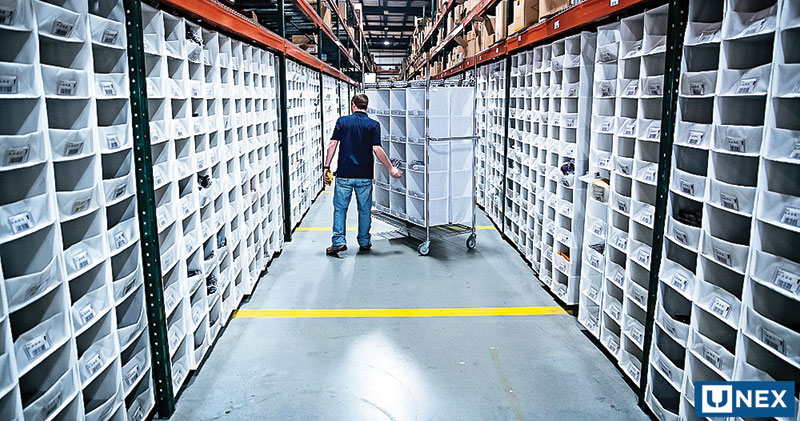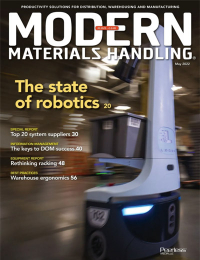Rethinking racking
From materials shortages to labor shortages, the racking industry is helping customers make the most of their cube.
If there’s a word to describe the state of the supply chain over the past two years, it’s disruption. From the pandemic to labor shortages, to black swan events like a ship blocking the Suez Canal and the war in Ukraine, nothing has gone as the industry expected.
With no end in sight, companies are rethinking how they operate going forward. From the supplier to the manufacturer to the customer, many links of the supply chain have come up short of late—and the fallout continues.
One piece of the fallout is a current slowdown of the former popular approach of lean warehousing/just-in-time (JIT) warehousing. While e-commerce is demanding that products be available and ready to ship in rapid fire, too many companies have been burned since 2020 with having too little inventory on hand. There’s a bit of a return to onshoring to keep production closer at hand. There’s an even bigger return to holding safety stock and larger amounts of inventory.
As a consequence, companies are adding new distribution centers, expanding the footprint of those they already operate when possible, or maximizing their existing space to the best of their ability. For racking and shelving manufacturers, this means plenty of demand to keep their businesses humming.
But these same manufacturers have also felt the impact of the supply chain disruptions, and in some cases, found themselves hurting for the steel and other supplies they need. The result is that just like everyone else, racking manufacturers must find the delicate balance of having enough inventory on hand for customer demand, and overcoming materials shortages, rising costs and rethinking the supply chain in general.
Providing customer solutions
Many factors are intersecting at once and impacting what warehousing customers need from their racking, says Don Heemstra, vice president of sales and marketing at Steel King. “They are hot and heavy with activity,” he explains. “They’ve learned, also, that getting their products is not a guarantee anymore, so they’re adding safety stock. That equates to more and different types of racking.”
These customers are ordering their products more often and sooner than in the past, says Heemstra. “There are too many unknowns, and they need to have stock on hand,” he says. “And with fewer customers going into stores anymore, warehouses have to put more emphasis on last-mile delivery and getting products out in 24 to 48 hours.”
Ed Granger, director of sales at Quantum Storage Systems, says that top-line sales for racking are staying strong, even as prices go up to meet the uptick in supply costs. “This is a universal problem, and people understand the need for pricing increases,” he says. “Everyone has to raise prices, so it seems to keep things status quo.”

Still, companies are always looking for ways to operate with less overhead. In warehousing, that means rethinking rack configurations, trying to better use their existing space. One of the ways companies are managing the extra need for racking is to add elevated structures like mezzanines. “Companies are packing their storage tighter together, higher and looking to max out their cubes,” Heemstra says. “They’re looking to fit in as many SKUs as possible without having to add more DCs.”
Megan Baker, director of marketing at UNEX, agrees. “We talk with our customers about making the most of their existing space,” she says. “From an efficiency standpoint, when the focus is on space optimization, everything else falls into place.”
Baker says this means customers need to be smart about the solutions they choose. “We specialize in storing SKUs according to throughput, using the right solutions,” she says. “This leads to significant cost savings from labor and square footage, offsetting some of the rising costs elsewhere.”
Played out, this looks like picking from a smaller, more condensed area. “People walk fewer steps to accomplish their jobs,” Baker says. “The less time you spend walking around the DC looking for product, the more you save in labor.”
UNEX customer HelloFresh, a meal-kit subscription service, is a good example of this in action. As demand for its products skyrocketed, the company looked for a way to maintain fulfillment levels, as well as accommodate future growth. UNEX created a custom modular flow-rack solution that increased the number of lines from 18 to 28, created return lines for empty boxes, and improved ergonomics at the same time.
Likewise, Steel King helped customer GLK Foods optimize space by designing a flow-rack system that facilitated first-in, first-out (FIFO) storage. They built the racking up, tripling GLK’s storage capacity, which helped the company avoid adding a new warehouse. It also increased the speed of operations, saving what the company estimates to be 150 hours of forklift double-handling in one busy harvest season alone.
With the labor shortage having a big impact on warehousing operations, companies are also getting creative with automation and racking combinations.
“Racking is static, but it’s the foundation that ties into automation,” says Heemstra. “This can range from very simple, like a conveyor feeding a shipping platform, to more complex, like shuttle systems that run up and down an aisle, moving pallets in and out.”
Cranes and robots are also integrating with racking at higher rates. But the placements of racking must be precise, says Heemstra.
“The robots need the specs on the height, beams and frames in a system,” he says. “The robots are always looking for 52-inch horizontal components, for example, and there can’t be variation there. Sensors are helping improve their ability with managing variation, but it still has a way to go.”
Lacking racking
Just as racking customers are struggling with a lack of inventory, so too are racking manufacturers faced with similar issues. “This is probably the most challenging time I’ve seen in my career,” says Granger. “Almost all of our wire shelving comes from overseas, so the disruptions have hit us on the nose.”
Heemstra says there’s less squeeze on racking materials over the past few months than earlier in the pandemic, but lead times are still longer than normal. “Getting materials when we needed them was a big challenge for a while,” he says. “We’d place an order in April and not receive it until October.”
With a raw materials inventory shortage hitting the industry hard, most rack manufacturers have had no choice but to pass along costs to customers. “Sea container pricing increased substantially over the past year,” says Granger. “Not only have we waited longer for product, but we’ve realized enormous price increases just to get product from China to the United States. Inventory is now better than it was, but container prices are still high and this has a domino effect on our own pricing.”
The same has held true for Steel King, says Heemstra: “If our materials prices went up, so did our product prices.”
Baker adds: “The disruptions and shortages have been a tough pill to swallow for many companies. There have been across-the-board pricing increases, so companies must be smart with their solutions.”
In advance of the materials shortages, Granger says that Quantum had inventory stocked and ready to respond to customer demand. “We’ve gained a lot of new customers in the past 15 months because we had product in stock and their old suppliers didn’t,” he says.
With steel prices rising and supply tight, Granger says that Quantum has become innovative and is launching a new line of plastic shelving.
“It mirrors our wire shelving units in load capacity, keeping with our light- to medium-duty range of up to 2,000 pounds per unit,” he says. “A year ago, it might have cost more than wire shelving, but in the current environment, that’s not the case. I think it could become our hottest commodity based on the industry’s inability to get imported wire shelving.”
Looking ahead to the remainder of the year, the manufacturers don’t see an end to shortages and disruptions, but perhaps a leveling off. The ability to pivot, get creative and maximize the cube will set companies apart from the competition. Heemstra sees Big Box retailers with a big advantage. “They have fixed assets and are adding micro-fulfillment centers in the back of stores so that they can handle same-day, partial shipments,” he says.
The past two years have presented unprecedented challenges for racking manufacturers and their customers alike. Together, however, they are coming up with creative solutions and changing with the times. “We’re still seeing many of these issues shake out,” says Heemstra. “It’s truly a rethinking of the entire supply chain.”

Article Topics
Rack News & Resources
Steele Solutions showcases advanced structural steel platforms and materials handling chutes Frazier shows Pallet Spacing System and Method Steel King Industries announces strategic collaboration with Automha Americas AR Racking joins Global Cold Chain Alliance Conventional warehousing update NA and VNA trucks: Jumping on the narrow aisle trend Mallard Manufacturing to open innovation lab More RackLatest in Materials Handling
Geek+ and System Teknik deploy PopPick solution for pharmacy group Med24.dk Beckhoff USA opens new office in Austin, Texas Manhattan Associates selects TeamViewer as partner for warehouse vision picking ASME Foundation wins grant for technical workforce development The (Not So) Secret Weapons: How Key Cabinets and Asset Management Lockers Are Changing Supply Chain Operations MODEX C-Suite Interview with Harold Vanasse: The perfect blend of automation and sustainability Consultant and industry leader John M. Hill passes on at age 86 More Materials HandlingAbout the Author
Subscribe to Materials Handling Magazine

Find out what the world's most innovative companies are doing to improve productivity in their plants and distribution centers.
Start your FREE subscription today.
April 2024 Modern Materials Handling

Latest Resources












